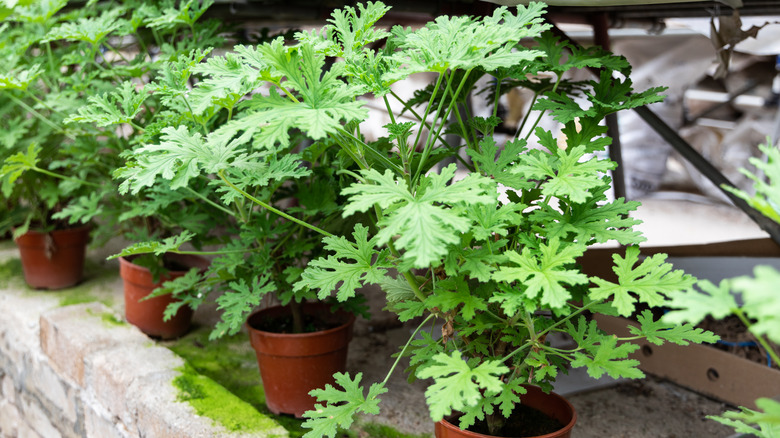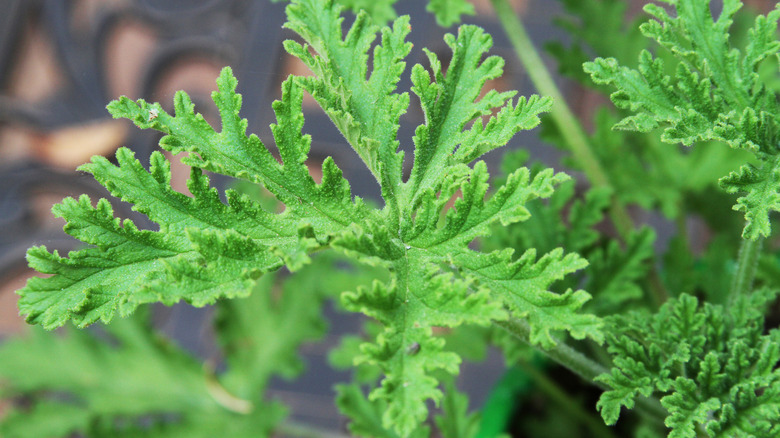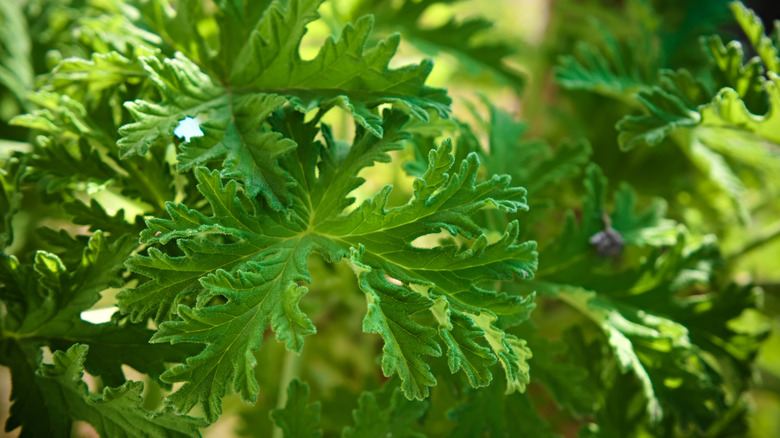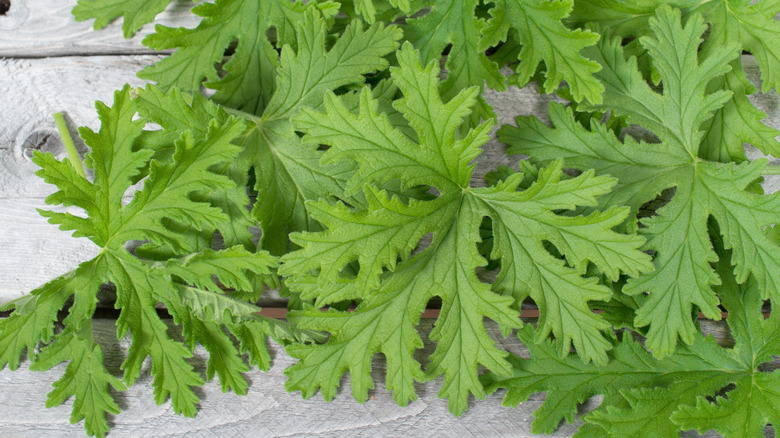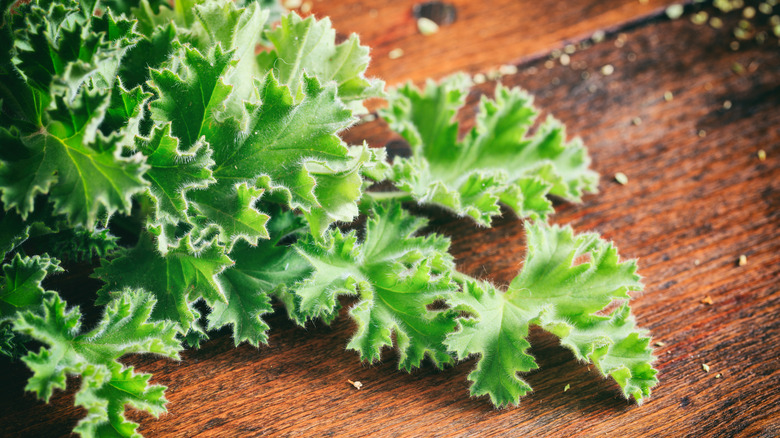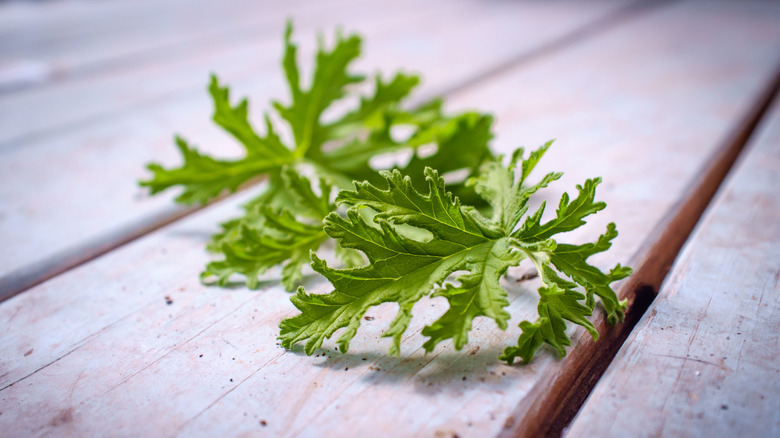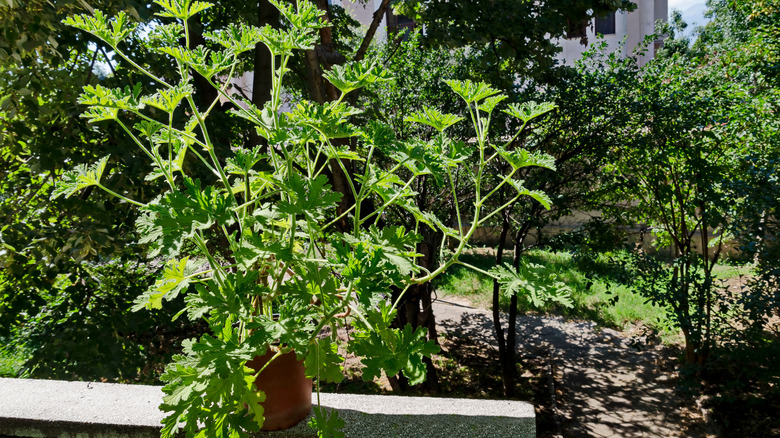Tips On Keeping Citronella Mosquito Plants Alive
Citronella plants (Pelargonium 'Citrosum'), also known as mosquito plants, are a variety of scented geranium that produces the same citronella fragrance as the well-known candles, according to Gardening Know How. Genuine citronella oil is actually derived from a species of lemongrass, whereas this variety merely mimics the effect with a similar scent. Some sources claim that this variety was developed by combining the genes of Chinese citronella grass with those of an African geranium, but research conducted by scientists at Delaware State University has debunked this as myth, explains Ritchers.
While they aren't the plant that produces citronella oil, some individuals find citronella plants to be extremely effective at repelling mosquitoes. They are also a more attractive option for people designing their backyard or patio, as they tend to be less expensive and longer-lasting than citronella candles. Others are more skeptical of the pest-repelling properties and instead use them as decorative, scented plants. Either way, they are very easy to care for and maintain. Overall, citronella mosquito plants are a great plant to care for in the warmer months, for both practical and visual reasons.
How to use citronella mosquito plant in garden
The most common way to use mosquito plants is, as the name suggests, to repel mosquitoes. According to Bonnie Plants, citronella plants grow best in USDA zones 9 through 11, where climates are warm enough that they can grow and be maintained as a perennial. In colder regions where winter brings freezing temperatures, the plant can instead be grown as an annual. While you can bring it inside to overwinter like other geraniums, the scent may be a little intense.
If you want to create a totally pest-free garden to enjoy the outdoors in peace, consider planting citronella alongside various other pest-repelling plants. According to Life Hacker, other plants that bugs avoid include basil, tomato, rosemary, and catnip. You can also add marigolds, which even repel rabbits, though they do tend to attract garden slugs. To keep the slimy slugs away, Life Hacker recommends planting chervil, also known as French parsley, around the perimeter of your garden bed or alongside your marigold plants.
How to grow citronella mosquito plant
To get a citronella plant, take a trip to your local garden center when the weather gets warm — there will be rows of the fragrant plant lining the shelves. They can also be grown via propagation. This can be done any time of year, though Hunker explains that the best time is outside of the summer blooming season, from fall until early spring. They can be propagated in water or in soil, though the latter is far more reliable, as water propagations can rot before they grow sufficient roots.
Begin by preparing a propagation pot with a sterile planting mix that contains vermiculite, peat, and/or sand. Next, assess the mother citronella plant for a healthy stem at least 3 to 5 inches long. Remove all the leaves except the top few, and dip the cut end into rooting powder. Push the stem into the soil, and make sure at least three nodes are buried below the surface. You can place a few cuttings in one pot, but make sure the leaves don't touch — geraniums generally don't like to be crowded.
Keep the cuttings inside by a bright, sunny window, and cover the propagations in a tent of plastic to increase humidity. Keep the soil consistently moist, not soggy, and temperature at 65 to 75 degrees. After four weeks or so, tug gently on the plant's stem. If it resists, it's rooted and ready to be repotted. If not, it needs more time.
How to care for citronella mosquito plants
Caring for citronella mosquito plants is very easy. Per Gardening Know How, they require at least six hours of sun a day, either outside or by a window that receives sufficient sunlight. They will tolerate partial shade if you can't give them access to direct sun, though they may not flourish. As for soil, they can really tolerate any type after propagation, as long as it's well-draining. They can benefit from a little bit of organic matter, such as peat, compost, or perlite, according to Gilmour.
Potted citronella mosquito plants, indoors or out, should be watered somewhat frequently, and not be left to dry out. In the ground, though, they can endure a little bit of neglect. Consider fertilizing potted citronella mosquito plants with a basic, all-purpose liquid fertilizer. For in-ground perennial citronella plants, this isn't necessary, though they may benefit from a slow-release, granular fertilizer. Prune off old, dead, or misshapen leaves and branches regularly to prevent disease and to encourage full growth.
Citronella mosquito plant varieties
While citronella mosquito plants are not the actual plant that derives citronella oil, it still produces a nearly identical scent and has similar success in repelling mosquitos. It is not the only plant to produce the trademark scent, though. Per Morning Chores, here are a few more species of plants that have a citronella aroma like citronella mosquito plants:
-
Cymbopogon citratus: West Indian Lemongrass, as it's commonly called, is one of the plants that produces citronella oil and is used to repel mosquitoes.
-
Cymbopogon flexuosus: Also known as East Indian Lemongrass, this plant is related to Cymbopogon citratus, and is frequently used to flavor food and as a scent boost in cosmetic products.
-
Cymbopogon nardus: Known commonly as Ceylon citronella, this is the most common plant that home gardeners grow to harvest citronella oil. It also grows as an ornamental grass — great for landscaping!
-
Cymbopogon winterianus: Java citronella is another ornamental grass that produces a citronella scent, growing larger and faster than the Ceylon variety.
Are citronella mosquito plants toxic?
Citronella mosquito plants are toxic to dogs and cats. According to the ASPCA, the scented geranium mainly causes gastrointestinal issues, such as vomiting and diarrhea. It can also cause ataxia and muscle weakness, depression, and hypothermia. Cats are especially vulnerable to more severe reactions upon ingestion. Call your vet immediately if you see your pet eating the plant, or if you suspect they have and they're displaying symptoms. Pets pawing at or rubbing on the plant can also experience contact dermatitis, advises Gardening Know How.
Geraniums in general can also cause skin irritation to humans, warns DermNet NZ. For flowering geraniums, this most commonly occurs during deadheading, but it can also occur during pruning or regular maintenance. Take care to wash your hands after handling the plant to avoid this altogether. That being said, some people find the citronella scent of the plant to be more potent when crushed and rubbed on the skin, per Mudbrick Herb Cottage, though there is no scientific evidence to back this up.
How to repot citronella mosquito plant
Growing citronella mosquito plants in pots is a great way to care for the plant as a perennial in colder climates, as you can easily move it in and outdoors as the seasons change and weather fluctuates. Repotting will need to be done as the plant and its root system get larger. Once the plant has reached its full size, you should still uproot it every couple of years to refresh the old soil and remove dead roots.
Per SFGate, the plant's new pot should be about two inches larger than its previous one. Fill the container about a third of the way up with well-draining soil incorporating sand, peat, and/or compost. Carefully remove the plant from its current pot, and using your hands, gently massage the roots to remove as much depleted soil as possible. Assess the roots, and remove any mushy, old, rotten, or darkened sections. Add the plant to the new pot, doing your best to position it at the same depth as before. Fill the remaining space with soil up to the crown of the plant. Water thoroughly to expose air pockets, and then fill those in with soil as well. Water again and let drain thoroughly.
